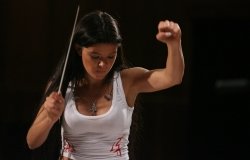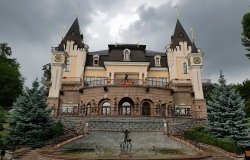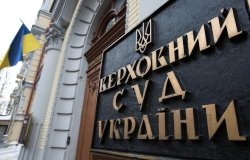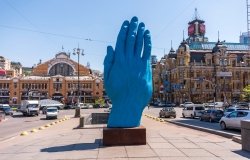
A blog of the Kennan Institute
Keeping a Front-Line City Inhabitable: The Role of the Opera and Ballet in Sustaining Kharkiv

A generation from now when Ukrainians look back at the horrendous war now underway, they undoubtedly will hold Kharkiv’s musical community in special regard. The eastern Ukrainian metropolis came under fierce attack at the very beginning of the February 2022 invasion, only saved from Russian occupation by fierce fighting.
The city has remained under attack from the air. Though sporadic, rockets have fallen on Kharkiv relatively unhindered, as the city lacks the more reliable air defenses of Ukraine’s capital Kyiv. The city’s residential neighborhoods have been decimated, and its main public squares destroyed, despite the best efforts of heroic defenders and a now legendary fire department.
The city’s massive late-Soviet era opera house has not escaped harm. Situated on the city’s main Freedom Square that has sustained massive damage, the opera house has lost electricity, many windows, and most basic services. Opera company director Oleksii Duhinov reports that 250 of his singers, dancers, technicians, and other staff successfully evacuated to Lithuania and have pursued any and all opportunities to perform outside Ukraine.
Ten company members serve in the army, and one member of the technical staff was killed at the front. Twenty musicians, sixteen chorus members, four dancers, and nine operatic soloists have remained. For nearly two years, they have performed in metro stations, bomb shelters, destroyed apartment building basements, and city streets. They have appeared constantly, at times as close as three miles from the front lines. Their simple yet powerful performances have lifted the spirits of the city’s remaining residents, first responders, and soldiers. Over time, Duhinov has reported, the performers have shelved their operatic repertoire for more popular music that more easily helps soldiers relax.
During the better weather of spring and summer, the remaining dancers have practiced for a quick tour to Germany in open-air studios. They have moved to the theater’s considerable underground storage and technical spaces as winter sets in once more. Their performances take place in central underground car parks and other protected spaces, as their main auditorium remains off-limits for safety reasons.
Much of this effort has been voluntary, as sponsors are difficult to find. Those artists who remain need to continue practicing and performing, since sitting idle does not help dancers and singers who seek to continue their careers. The focus on giving performances for those injured and in danger represents a civic mission to sustain Kharkiv as a center for the arts, much as local university professors continue to teach in order to maintain their city’s standing as one of Ukraine’s leading intellectual centers.
Survival under such extreme conditions depends on more than goodwill. Company dancers in exile and at home would welcome paid collaborations to help sustain their craft. Duhinov reports that the company welcomes collaboration with other arts institutions abroad. It needs equipment—generators, heating equipment, lights, costumes—to keep going through what promises to be a difficult winter. Support from international peers becomes more important as the war grinds on into its second winter.
The Kharkiv National Academic Opera and Ballet theater company has chosen not to back away from an existential threat. Like Ukrainian society at large, its artists, staff, and managers have understood that they have a role to play in preserving and advancing a Ukrainian culture that the Russians have sought to destroy. They continue to do so despite unspeakable hardship.
Architects originally intended that Kharkiv’s opera house—which took a quarter of a century to build as the Soviet Union collapsed around it—serve as a Communist Party congress hall, complete with a stage large enough for military vehicles. Converted to a theater midway through construction, the building’s initial military intent has sadly taken on altered meaning. Rather than accommodating equipment for an army, the building is a center for resisting armed invasion.
The opinions expressed in this article are those solely of the author and do not reflect the views of the Kennan Institute
See our newest content first.
Subscribe to receive the latest analysis from Focus Ukraine
About the Author

Blair A. Ruble
Former Wilson Center Vice President for Programs (2014-2017); Director of the Comparative Urban Studies Program/Urban Sustainability Laboratory (1992-2017); Director of the Kennan Institute for Advanced Russian Studies (1989-2012) and Director of the Program on Global Sustainability and Resilience (2012-2014)

Kennan Institute
The Kennan Institute is the premier US center for advanced research on Eurasia and the oldest and largest regional program at the Woodrow Wilson International Center for Scholars. The Kennan Institute is committed to improving American understanding of Russia, Ukraine, Central Asia, the South Caucasus, and the surrounding region though research and exchange. Read more











